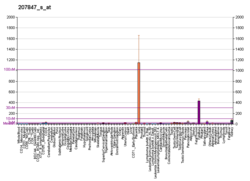Mucin short variant S1, also called polymorphic epithelial mucin (PEM) or epithelial membrane antigen (EMA), is a mucin encoded by the MUC1 gene in humans.[3] Mucin short variant S1 is a glycoprotein with extensive O-linked glycosylation of its extracellular domain. Mucins line the apical surface of epithelial cells in the lungs, stomach, intestines, eyes and several other organs.[4] Mucins protect the body from infection by pathogen binding to oligosaccharides in the extracellular domain, preventing the pathogen from reaching the cell surface.[5] Overexpression of MUC1 is often associated with colon, breast, ovarian, lung and pancreatic cancers.[6] Joyce Taylor-Papadimitriou identified and characterised the antigen during her work with breast and ovarian tumors.
- ^ a b c GRCh38: Ensembl release 89: ENSG00000185499 – Ensembl, May 2017
- ^ "Human PubMed Reference:". National Center for Biotechnology Information, U.S. National Library of Medicine.
- ^ Gendler SJ, Lancaster CA, Taylor-Papadimitriou J, Duhig T, Peat N, Burchell J, Pemberton L, Lalani EN, Wilson D (September 1990). "Molecular cloning and expression of human tumor-associated polymorphic epithelial mucin". The Journal of Biological Chemistry. 265 (25): 15286–93. doi:10.1016/S0021-9258(18)77254-2. PMID 1697589.
- ^ Hollingsworth MA, Swanson BJ (January 2004). "Mucins in cancer: protection and control of the cell surface". Nature Reviews Cancer. 4 (1): 45–60. doi:10.1038/nrc1251. PMID 14681689. S2CID 23171728.
- ^ Moncada DM, Kammanadiminiti SJ, Chadee K (July 2003). "Mucin and Toll-like receptors in host defense against intestinal parasites". Trends Parasitol. 19 (7): 305–311. doi:10.1016/S1471-4922(03)00122-3. PMID 12855381.
- ^ Gendler SJ (July 2001). "MUC1, the renaissance molecule". J. Mammary Gland Biol Neoplasia. 6 (3): 339–353. doi:10.1023/A:1011379725811. PMID 11547902. S2CID 32520673.





